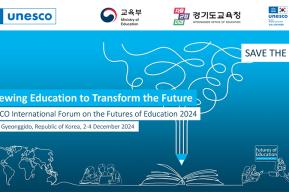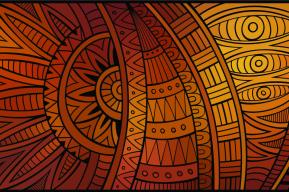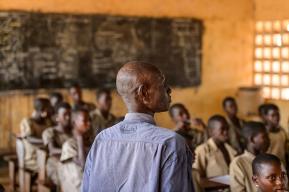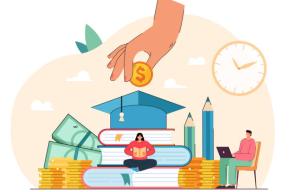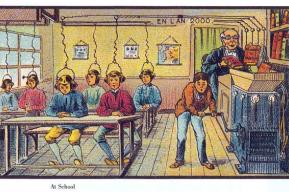Idea
Staying with the trouble: Scenarios and the future of education

This IdeasLAB blog is part of a series leading up to the launch of a publication on the theme of “renewing the social contract for education.” The theme of the series is based on the call from the report Reimagining Our Futures Together: A new social contract for education. See the full article, and look for the full special issue in Prospects to be released in early 2024. :
By Matt Finch, Niamh Ní Bhroin & Steffen Krüger
Education is, among other things, a way of preparing for times to come. We learn our way into every tomorrow. Whether education is seen as a policymaker's tool for change, ensuring that cherished values or practices continue, a space of unfettered exploration, or a venue for becoming a particular kind of person, it has a privileged relationship with the future.
Yet, uncertainties abound. In what context will education take place? Who will be the actors in the teaching and learning ecosystems of tomorrow? What spaces, physical and virtual, will those actors inhabit? How will they relate to one another, and what value will their interactions create?
In this post, based on our recent article for Prospects (Finch et al., 2023), we demonstrate how a strategic foresight technique known as scenario planning can be used as a tool to reckon with uncertainties which affect the field of education. These insights derive from a project at the University of Oslo, Norway, exploring the potential futures of schooling using the Oxford Scenario Planning Approach.
This is a way of exploring strategic uncertainty which sits alongside and in critical dialogue with other approaches, including futures literacy (Miller, 2022), causal layered analysis (Inayatullah, 1998), and the education futures work of Keri Facer (Facer & Sriprakash, 2021).
"Education is, among other things, a way of preparing for times to come. We learn our way into every tomorrow"
Scenario planning in the Oxford tradition involves the deliberate manufacture of plausible future contexts for an issue, institution, or community. When we face the so-called “TUNA conditions” characterised by turbulence, unpredictable uncertainty, novelty, and ambiguity, and we cannot be sure that conditions tomorrow will be like those faced in the past, scenarios can provide a useful tool for collectively thinking through matters of strategy and policy (Ramírez and Wilkinson, 2016).
While the Oslo exercise took place at the end of 2019, little did we then know how useful scenario planning would prove to be only a few months later in rapidly adjusting to a global pandemic. Although the resulting scenarios are set in times to come, they allow us to - in the words of Donna Haraway (2016) - "stay with the trouble" of the here and now.
Importantly, scenario planning offers a way to confront the limits of how we perceive our present situation and address the turbulent, uncertain nature of the circumstances in which we are entangled.
Developing the Oslo scenarios
Building scenarios allows participants to grapple with the uncertainties in the present-day context and consider their implications for the choices we face here and now. In late 2019, the University of Oslo's Department of Media and Communication created a set of scenarios for the future of Norwegian education, set in the year 2050 (Finch 2020). Teachers and headteachers, representatives of tech firms, government agencies, non-governmental organizations and policymakers had been invited to join researchers in a scenario planning seminar to address the increasing digitalisation and datafication of primary and secondary schooling in Norway. Such a shift has raised concerns about the involvement of commercial entities in education and uncertainty about its longer-term consequences for children's futures.
The scenario planning project was grounded in the perspective of Norwegian headteachers, who are responsible for running each school in accordance with relevant legislation and guidelines while meeting the needs of each unique student body and local community. Scenarios were built by participants exploring how uncertainties surrounding the world of the typical headteacher might play out over a thirty-year timeline, addressing expectations and assumptions about the future of digitalised teaching and learning. The resulting scenarios, describing potential future contexts for the digitalisation of education in Norway, offered broader perspectives on the Norwegian educational landscape in times to come, combining plausibility, relevance, and challenge to current expectations.
The first scenario, "The Child Who Had To Grow Up", depicted a climate-ravaged postcapitalist world on the brink of collapse. The economics of profit and net worth had given way, out of necessity, to a more equitable one of yield and fair distribution. Adults were occupied with the pressing need to address environmental emergencies, while children and teens were self-educated across age groups in advanced interactive virtual environments. Education was more about exploration than instruction, and the increasing independence of students challenged the current boundary between adolescence and adulthood.
Scenarios were built by participants exploring how uncertainties surrounding the world of the typical headteacher might play out over a thirty-year timeline, addressing expectations and assumptions about the future of digitalised teaching and learning.
In the second scenario, "Norway Prime", Norwegians were considered as employees as much as citizens in a world of corporate dominance: big business and the state were deeply entwined. Surveillance was the norm, privacy was dead, and advanced automated systems, including artificial intelligence, provided people with physical comfort at the price of conformity. Education took place in the home and was tailored to develop the workers of tomorrow. In this scenario, children's health and wellbeing became the last battleground between parents and institutions, as carers argued – against the prescriptions of corporate algorithms assessing health according to their quantitative criteria – that they knew what was best for their children.
Finally, in the "Make Norway Great Again" scenario, the oil-rich nation's plans for "life after fossil fuels" collapsed after economic and financial shocks, sending Norway into a spiralling decline. Schools remained remarkably similar to the institutions we know today. Still, they operated in an impoverished environment characterised by social tensions and authoritarian politics.
When trouble hit: scenarios as a foretaste of turbulence
The above scenarios were refined by the research team in collaboration with external respondents and published in March 2020 – coincidentally, just as Norway was challenged by its first COVID-19 cases. Several issues identified in the scenarios swiftly rose to prominence; the way in which they did so, we think, pertains directly to UNESCO's "new social contract for education" (UNESCO 2021). Thus, young learners working remotely from home quickly had to take more responsibility for their learning, as in the “The Child Who Had To Grow Up” scenario. This shift in responsibility showed how the five dimensions of education identified in UNESCO’s report – pedagogy, curricula, teaching, schools, and other educational opportunities – were fundamentally changed and challenged by a sudden shift in life’s broader social and ecological conditions.
COVID-19 also gave us an apparent foretaste of “The Child Who Had To Grow Up” scenario’s economic concerns, as policymakers had to trade off productivity against the health and safety of citizens, and the convenience of “just in time” supply chains gave way to “just in case” procurement of masks, ventilators, and other medical equipment.
In parallel, during the early stages of the pandemic, those Norwegian parents whose assessment of COVID-19’s threat to their children’s health differed from that of the state, lobbied for school closures on Facebook – taking a battle over perceptions of wellbeing into digital spaces akin to those posited in the “Norway Prime” scenario.
The digital terrain of education became privatised too, though, in actuality, it was Microsoft, and not Amazon, that had managed to secure the deal for schooling in Norway. In April 2020, the corporation announced that its “Teams” tool had more than doubled its user base, seeming to confirm Norwegian parents’ impression that this online medium was influencing their reality and that of their children.
Finally, the economic shocks of COVID-19, including the slowing of the oil market, caused Norway to engage in public spending at a scale unprecedented in peacetime, breaking a self-imposed cap on the nation’s sovereign wealth fund like that which had appeared in “Make Norway Great Again”.
Events and dynamics that had seemed the province of challenging, distant, scenarios prior to COVID-19 were suddenly becoming all too real in the here and now.
Staying with the trouble: using plausible futures for fresh perspectives
No one has privileged access to the future, and it is impossible to gather data and evidence from events which have not happened yet. Even when foreseeable trends seem to exist, "the experience of COVID-19 has reminded us how easily a seemingly inevitable curve can be bent or broken by events which decision-makers had not accounted for" (Finch and Mahon, 2021).
Similarly, the Oslo scenario set was by no means a matter of "correct prediction." Instead, it provided strategic value by allowing participants to successfully expand the frame of reference through which scenario learners perceived that the world could unfold.
Each scenario offers a fresh perspective from which to shine a light on the issues of today, looking beyond the framing of the here and now to see things differently and thus "reimagine our futures together".
Hence, as we contemplate a new social contract for education, the Oslo scenarios show how the context for that social contract might unfold within and beyond our various expectations, predictions, intentions, hopes, and fears. Each scenario offers a fresh perspective from which to shine a light on the issues of today, looking beyond the framing of the here and now to see things differently and thus "reimagine our futures together".
The lesson from our scenario work is that each dimension of education needs to be considered in a range of different and challenging futures across life, and different social and cultural spaces. By doing this, we ensure that the new social contract for education is written in dialogue with the ever-changing contextual conditions of our uncertain world, helping us all to "learn our way into every tomorrow".
References
Facer, K., & Sriprakash, A. (2021). Provincialising futures literacy: A caution against codification. Futures, 133, 102807. https://doi.org/10.1016/j.futures.2021.102807
Finch, M. (2020) Schools and/or screens: scenarios for the digitalisation of education in Norway. University of Oslo. https://booksadventures.files.wordpress.com/2020/03/oslo-future-of-schools-scenarios.pdf
Finch, M., Bhroin, N.N. & Krüger, S. (2023). Unlearning, relearning, staying with the trouble: Scenarios and the future of education. Prospects. https://doi.org/10.1007/s11125-023-09664-7
Finch, M., & Mahon, M. (2021). Tales of the times to come: The humanities and scenario planning. Irish Humanities Alliance. https://www.irishhumanities.com/blog/tales-of-the-times-to-come-the-humanities-and-scenario-planning/
Haraway, D. (2016). Staying with the trouble: Making kin in the Chthulucene. Duke University Press.
Inayatullah, S. (1998). Causal layered analysis: Poststructuralism as method. Futures, 30(8), 815-829. https://doi.org/10.1016/S0016-3287(98)00086-X
Miller, R. (2022). Imagination in the service of education futures. UNESCO. https://www.unesco.org/en/articles/imagination-service-education-futures?hub=81942
Ramírez, R., & Wilkinson, A. (2016). Strategic reframing: The Oxford scenario planning approach. Oxford University Press.
UNESCO (2021). Reimagining our futures together: A new social contract for education. Report from the International Commission on the Futures of Education. https://unesdoc.unesco.org/ark:/48223/pf0000379707
The ideas expressed here are those of the authors; they are not necessarily the official position of UNESCO and do not commit the Organization.
Author Biographies:
Matt Finch is a strategy and foresight practitioner at the Saïd Business School, Oxford University, United Kingdom.
Niamh Ní Bhroin is an Associate Professor in Media Studies at the University of Agder, Norway.
Steffen Krüger is Senior Lecturer in the Department of Media and Communication of the University of Oslo, Norway.



